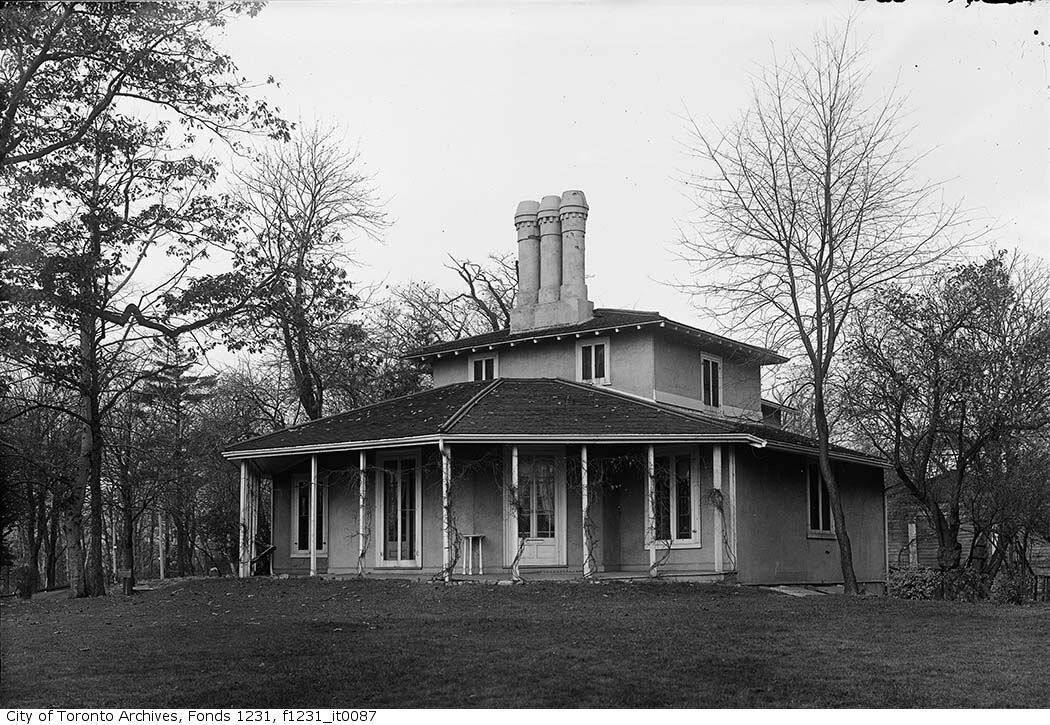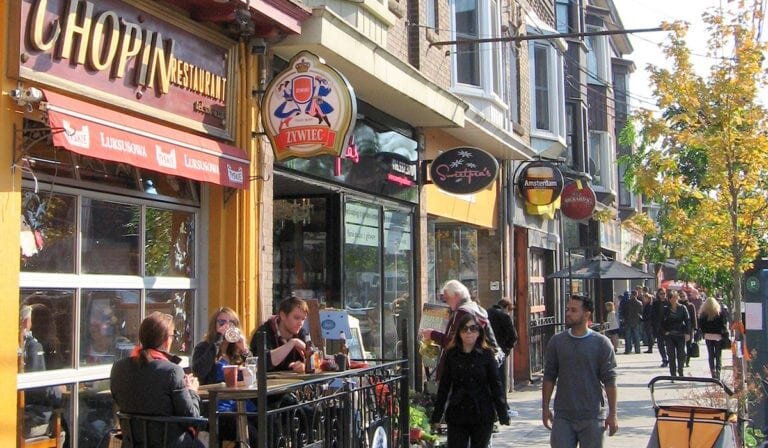
Roncesvalles Village still finds a way for authentic Polish butchers, bakeries and restaurants to thrive among a destination-worthy set of restaurants, boutiques and indie coffee houses. Mix in popular pubs, a beautiful old church and late night burgers and drinks and you've got yourself a neighbourhood that's no longer one of Toronto's best kept secrets.
The History of Roncesvalles
Toronto's first highway to the west was Dundas Street starting at Queen Street along today's Ossington and west along its current path west to Dundas (near Hamilton). While Toronto's boundary was Dufferin Street, a very early village mostly built around hotels sprang up along Dundas just before it met Ossington and entered Toronto. This was Brockton. The subdivision of land for Brockton included the portion of the neighbourhood east of what is now Roncesvalles Avenue, although there was little development there at the time. The rest of what is now the Roncesvalles neighbourhood began as farm lots given to Toronto's prominent Ridout family and the architect John George Howard. These men had careers in the city so little was done with their farmland most of which was never even cleared of the natural forest. Two houses were built by John Howard on these farms: Sunnyside (where St. Joseph's Hospital is now), and Colborne Lodge (Mr. Howard's own cottage built 1837) in what is now High Park. A path running through Sunnyside Farm was an Indigenous trail (now Indian Road) thought to have originally been an ancient Mississauga Indian path, leading from Lake Ontario north. In the 1850s, concurrent with the building of the railway, the central part of Brockton was separated from the Roncesvalles subdivided lands except for a small strip along Dundas between the railway and Bloor.
In 1850, Colonel O'Hara acquired the land north of Queen from Roncesvalles Avenue to just east of Lansdowne Avenue. In 1874, Colonel O'Hara died and his land was subdivided. Following the subdivision of two other farms south of Queen, a new village rapidly took shape and in 1879 was incorporated, despite protests by the City of Toronto, as the Village of Parkdale. The subdivision of O'Hara's land and the streets laid out after his death had names related to his family, largely superseded the Brockton subdivision south of the railway between Roncesvalles and Sorauren. Development in Parkdale crept up Sorauren Ave and there was even some building on Roncesvalles Avenue before a series of annexations brought Parkdale (1889), Brockton (1884) and the surrounding farmland (including Sunnyside farm) into the City of Toronto. In all there were 13 separate annexations by the City of Toronto between 1883 and 1893.
When Parkdale was annexed to Toronto, streets were laid out or extended to Keele Street (the section south of Bloor was later renamed Parkside Drive) and the street grid took the shape it has to this day. In the 1890s the intersection of Roncesvalles and Queen became more important as a Lake Shore streetcar line was built, enabling commuting to the west. A streetcar yard was added at the intersection in 1895. The Sunnyside railway station at the intersection was opened in 1912.
At the turn of the 20th century, the first school was built in the neighbourhood, the Old Howard Park school on Boustead Avenue. Although a number of Victorian homes had already been built extending north from Parkdale, the neighbourhood was largely built from 1900 until the First World War with almost all houses built in the 'foursquare' style. Originally these homes were designed for the middle class while wealthier homes were found in Parkdale. Also at this time, the first four Carnegie Libraries were opened in Toronto. Apart from the Central Library these libraries were identical, one of them being the High Park branch on Roncesvalles Avenue. The three original churches were also built at this time; St Vincent de Paul (Roman Catholic), St Jude's (Anglican) and Howard Park Emmanuel (United Church). In the later years of its development, Roncesvalles began to attract some wealthier families and many impressive homes were built from 1910 to 1930 on High Park Gardens and High Park Boulevard.
The lakefront was developed by the Toronto Harbour Commission in the 1910s, leading to the development of the Sunnyside Beach and Amusement Park in 1922. Its popularity spurred development of the area commercially. The foot of Roncesvalles became a commercial and transportation hub, with a train station, a bus depot and the streetcar loop. The Park was demolished for the Gardiner Expressway project in 1955 and the Sunnyside intersection bypassed, leading to a decline in commerce and residential values in the area. The wealthy moved away from the area to newer suburbs further west and many large local homes were divided into apartments. However, Roncesvalles has remained largely middle class, attracting an influx of successful immigrants especially from Poland reversing the relationship between Roncesvalles and Parkdale. St Casimir's Catholic Parish was established in 1944. The construction of the church and church hall began in 1948 and was completed in 1954 by which time the Polish community had become well established in the area. It was the construction of the church that attracted the Polish immigrants to the immediate area.
Roncesvalles Today
Roncesvalles is known for its European ambience and small-town feel. This neighbourhood is popular with young families who appreciate the convenience of the location just west of downtown. The close proximity to High Park, Toronto waterfront bicycle and walking trails, easy access to public transit, and the Roncesvalles shops and restaurants are also popular.
The Roncesvalles Polish Festival, which takes place annually in September, attracts thousands of visitors. Roncesvalles Avenue is closed off for this festival that includes Polish dancers, children’s games and rides, polka bands and lots of food and refreshments.
Roncesvalles Avenue is a wide boulevard shared by pedestrians, cyclists, automobiles and streetcars. The heritage buildings that line Roncesvalles Avenue set the tone for the friendly atmosphere and old world charm that is Roncesvalles Village.
Roncesvalles Real Estate
Roncesvalles real estate is known for its European ambience and small-town feel. The neighbourhood is popular among young families and move up buyers, who appreciate the convenience of the location just west of downtown. The close proximity to High Park, Toronto waterfront bicycle and walking trails, easy access to public transit, and the Roncesvalles shops and restaurants are also popular credentials on many house-hunter’s lists.
Roncesvalles Village homes for sale are highly sought after by Toronto homebuyers. The beautiful Victorian and Edwardian century houses that line the streets of this neighbourhood are enjoying a revitalization with a new generation of homebuyers who appreciate the charm and character of these older homes and who are not afraid to put in a little work to create the home of their dreams.
Roncesvalles Village is brimming with beautiful turn-of-the-century homes that are accented with whimsical architectural details. Pretty front porches and well tended gardens compliment the pretty houses. A lush and mature tree canopy make for a very pleasing streetscape. Most of the houses are attached or semi-detached with a sprinkling of detached houses. Garages are tucked away out of sight at the rear of the house off laneways.
Looking for the best of Roncesvalles?
Parks
Schools
Please click here for a comprehensive list of schools in Roncesvalles..
Restaurants
Café Polonez: Homestyle Polish dishes and Eastern European fare in a warm, understated space with many Polish beers.
La Cubana: Pressed sandwiches & meats with rice and beans are served at this Cuban diner with a throwback vibe.
Barque Smokehouse: Lively local spot for traditional BBQ brisket, ribs, wings and such, with family night on Sunday.
Cafés
Reunion Coffee Roasters: At this white-tiled café, baked goods and java drinks made from its roastery's own beans are on offer.
Fantail: Quaint bakery/café with vintage-y décor serving creative baked goods and savoury fare.
Extra Butter Coffee: Craft javas, bottomless cups of drip coffee & sweet & savoury baked goods in art deco–ish setting.










